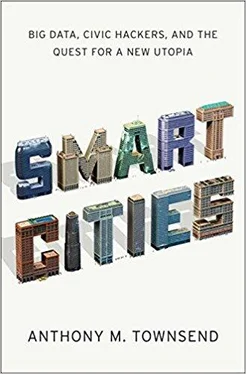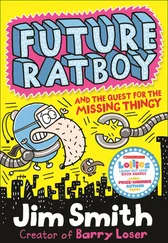In the meantime, governments and civic hackers swooped in with a surprisingly ample war chest. In 2013, the UK government committed €50 million (about $84 million) over five years to a smart-city tech accelerator in London, the Future Cities Catapult Centre. Meanwhile, the Chinese government unveiled a crash program to build a hundred smart cities, towns, and districts. The United Kingdom hopes to kick-start businesses that can export technology and solutions globally. China is looking to address its massive domestic market, which it pegs to grow to some $80 billion a year by 2025. According to an assessment published by the Knight Foundation, more than $430 million has been invested in over two hundred civic tech start-ups since 2011. Over $1 billion of venture investments targeted Internet of Tilings start-ups in 2013 alone.
Unfortunately, the risks inherent in smart cities have also snowballed. The Heartbleed security bug exposed in April 2014 showed how sloppy programming can introduce catastrophic flaws into the infrastructure of smart cities. In this case, a late-night coding error by a volunteer programmer went unnoticed for over two years by the many eyeballs of the open-source community, creating a pervasive hole in the most important tool for securing the Internet. Just before Thanksgiving in 2013, one of the largest thefts of sensitive consumer data in history occurred when hackers infiltrated the megaretailer Targets corporate intranet through an Internet- connected heating-and-cooling system. Similarly, reminders of the brittleness of smart-city systems are a daily occurrence—for instance, the February 2014 breakdown of taxi-hailing app Uber after a California data-center outage. And perhaps no level of alarm about government surveillance of citizens’ communications is unjustified in light of National Security Agency whistle-blower Edward Snowden’s alarming revelations during the summer of 2013.
Taken together, these rapid accelerations of the forces at play in smart cities foretell a colossal and potentially chaotic period of growth and transformation. But amid the haze of uncertainty, one final expectation-resetting investment boom provides hope: the birth of dozens of university research centers focused on the study of cities. For nearly a decade, MIT’s SENSEable City Lab seemed to stand alone in its focused exploration of big cities through the massive and growing plume of exhaust data they generate. But now, even more ambitious efforts to build a new quantitative understanding of cities are spinning up in New York, London, Chicago, Zurich, Singapore, Amsterdam, Madrid, Glasgow, and elsewhere. Collectively, they represent the greatest infusion of funding, talent, and new ideas into urban studies in a century.
The timing couldn’t be better. Because the one trend that seems to be bucking my expectation-beating pattern is the pace of urbanization itself. Even in China, India, and Africa, the expansion of cities seems to have abated, if ever so slightly. So while cities will continue to evolve on a scale and level of complexity we’ve never seen, they may yet grant us enough time to see if this crash program in decoding the nature of urbanization will yield fruit. It is becoming clear that some big discoveries are tantalizingly near. If we exploit these sorts of lessons and redesign our blueprints for the last great era of city building that lies ahead, we might just make it to the other side of the coming century.
I’ve had the great fortune of working with a number of mentors who have shaped my understanding of cities and technology and how they shape each other. More than anyone, Mitchell Moss at New York University taught me firsthand what cities are and how they work, and provided the opportunity for me to explore the emerging urban geography of the Internet in the mid-1990s. The late William Mitchell at MIT inspired and encouraged me to think more deeply about the role of place and physical design in the smart city. Our discussions about wireless networks and digital resilience in New York after September 11 frame many of the ideas in this book, and I proudly borrow its title from the research group he started at the Media Lab in 2003. Frank Popper at Rutgers University closed the loop between my interest in cities and my fascination with computers in 1995, handing me a copy of the US Office of Technology Assessment’s report The Technological Reshaping of Metropolitan America. Over the last decade, Michael Joroff' and Dennis Frenchman at MIT pulled me in on smart-city design projects all over the world and patiently demystified the players and strategies at work in the modern city-building industry.
The Institute for the Future is the world’s leading center for long-term thinking and has been my intellectual home since 2005. Without the support of my colleagues, this book would never have come to be. Marina Gorbis and Bob Johansen have helped me understand the science and art of long-range forecasting. The overarching framework for this book—the conflict between industry and the grassroots visions for smart cities—grew out of work with Kathi Vian and Michael Liebhold in 2006 on the future of context- aware computing. Kim Lawrence was indispensable in helping arrange the leave of absence that gave me the time to write.
In New York City I’ve been surrounded by a coterie of fellow thinkers and doers pushing the frontier of smart cities forward, and our conversations helped make this a better book—especially Greg Lindsay, Adam Greenfield, Laura Forlano, Andrew Blum, Jake Barton, Frank Hebbert, and Hugh O’Neill. Others outside the Big Apple who offered helpful comments on early drafts include Anna Ponting, Alex Soojung-Kim Pang, Francisca Rojas, and Rob Goodspeed. From my NYCwireless compatriots Terry Schmidt, Dustin Goodwin, Joe Plotkin, Dana Spiegel, Ben Serebin and Jacob Farkas I learned firsthand how to hack smart cities together at the hardware level.
The keenest eye of all has been that of my editor Brendan Curry, whose course corrections vastly improved this manuscript. My agent, Zoe Pagnamenta, has been an adept guide in the world of publishing. In the course of checking facts, Patricia Chui discovered dozens of details that have greatly enriched the stories told herein. Amanda Alampi compiled the hundreds of notes documenting my research, and, more importantly, helped me understand how to share the stories in this book through social media.
Generous financial support from Benjamin de la Pena of the Rockefeller Foundation through a grant for a study on “the future of cities, information and inclusion” planted the seed for this book, and additional follow-on funding from Carol Coletta of CEOs for Cities supported my initial writing. The Kauffman Foundation supported research on the role of entrepreneurs and start-ups in building smart cities. The Frederick Lewis Allen Memorial Room at the New York Public Library and the S. C. Williams Library at Stevens Institute of Technology provided workspaces for research and writing.
Richard and Roberta Townsend always allowed me from a young age to choose my own direction in life, and provided constant encouragement and support. My wife Nicole has been there always, as a sounding board, honing my reasoning and helping me actually turn some of these ideas into real projects. Finally, my brothers John Townsend and Bill Townsend, who were my original urban mentors, showed me the wonders of Boston and Washington as a teenager, and spurred my love of the city forever.
Preface
1 “America’s New Mobile Majority: A Look at Smartphone Owners in the U.S.” Nielsen Wire , blog, last modified May 7,2012, http://blog.nielsen.com/nielsenwire/?p=31688.
Introduction. Urbanization and Ubiquity
1 World Urbanization Prospects: The 2007 Revision (New York: United Nations, Department of Economic and Social Affairs, Population Division, February 2008), 1.
Читать дальше












